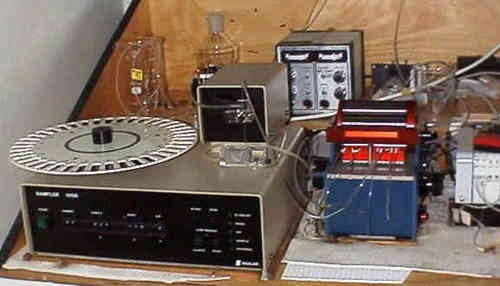| method | In acid solution and in the presence of molybdate-ions, ortho-phosphate forms a complex which is reduced to phosphorous-molybdenium-blue with ascorbic acid. Phosphate is detected photometrically at 880 nm using an auto-analyzer. (alternatively use Photometer method) | ||
| setup |  |
||
| solutions | |||
| reagent |
51 mM/L ammonium-molybdate
(NH4)2MoO4, 1.4 mM potassium-antimony-tartrate
(C4H4KO7Sb, Merck #108092) in 1.2M
H2SO4 |
||
| ascorbic acid | 45.4
mM/L ascorbic acid(C6H8O6) in pure
water with 0.2% Levor 4 (Aerosol 22, Sigma Aldrich #A9753): 0.8g ascorbic acid is dissolved in 100 ml pure water add 200ÁL Levor 4. Store cool in a brown glass bottle. |
||
| standard stock | 1000 ppm Phosphate Standard Merck #19898 | ||
| work solution | 1 mM/L (or 100 ppm) PO4 | ||
| work standards | 2.5 - 5 - 7.5 10 ÁM/L PO4 ( or 0.25 -0.5 - 0.75 - 1.0 ppm) in phosphate-free natural or artificial seawater. | ||
| analysis conditions | 4cm flow-through cuvette, linear range up to approx.10 ÁM/L (or 1ppm) PO4 | ||
| pump | peristaltic pump Ismatec | ||
| detection | ME flow-through Photometer with IR LED(880 nm) | ||
| recording | strip chart recorder 5V | ||
| analysis time | approx. 90 sec.per sample | ||
| setup scheme |  |
||
| pump tubes | sample air ascorbic acid reagent |
yellow-blue white-orange white orange white orange |
1.52 mm I.D. 0.64 mm I.D. 0.64 mm I.D. 0.64 mm I.D. |
| rinse | rinsing
between samples with seawater (or - according to samples - diluted
seawater) with 1ml/L 25% H2SO4. At dilutions greater than 1:10 rinse with 0.4% Levor 4 solution |
||
| tips + tricks | All
bottles and vials should be glass. Do not use plastic unless absolutely
necessary (pump tubes). Rinse all glassware with 1.5% HCl followed
by pure water prior to use in order to reduce phosphate background
from detergents If needed, the length of the final reaction coils may be increased in order to get higher sensitivity |
||